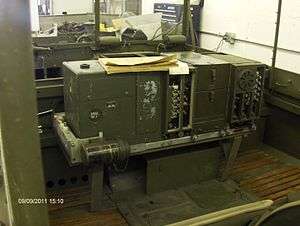SCR-508
The SCR-508 radio was a mobile Signal Corps Radio used by the U.S. Army during World War II, for short range ground communications. The SCR-508 series radio represented the Army's commitment to both FM and crystal tuning, and was used extensively by armor and mechanized units. The turret bustle of late series light and medium tanks was designed around this radio.[1][2]
| SCR-508 | |
|---|---|
 SCR-528 in M29 Weasel | |
| Type | Vehicle Radio |
| Place of origin | |
| Service history | |
| In service | 1941-1958 |
| Used by | US Army |
| Wars | World War II, Korean War |
| Production history | |
| Designed | 1940 |
| Produced | July 1941 |
| Variants | 2 |
| Specifications | |
Use
The SCR-508 series was standardized on 22 July 1941, and used by armored forces for command and control of tank units. It replaced the earlier SCR-293 and SCR-245 and was used primarily in the M5 light tanks as well as the M4 medium tanks. It also provided the intercom system to all crew stations. It provided voice communications between tanks and other vehicles/units equipped with FM radios (such as the SCR-510 and others) operating in the same frequency range. One of 10 channels could be selected by the operator, a total of 80 channels were available for use at 100 kHz channel spacing. Channels were referred to by a numerical identifier. For example, 27.100 MHz was "channel 271", 25.000 MHz was "channel 250" and so on. It was replaced by the AN/VRC-8 series radios.[3]
Components
- BC-604 transmitter (FM, CW/voice), 10 crystal controlled channels 20.0 MHz to 27.9 MHz, 25 watts, range 7 mi (11 km)
- DM-34 dynamotor (12 Volt input) or
- DM-36 dynamotor (24 Volt)
- BC-603 receiver (2 for 508 set)
- DM-35 dynamotor (12 volt input) or
- DM-37 dynamotor (24 volt)
- FT-237 mount or rack
- CH-74 cabinet for use in open command vehicles (FT-284 Legs)
- MP-52 mast base for CH-74
- MP-48 antenna base, and 9 ft (2.7 m) whip antenna
- CH-264 chest for parts and accessories (could be slid into mount in place of receiver)
- T-17 microphone
- HS-30 headset
- RM-29 telephone patch set
- BC-606 intercom box, at crew stations
- I-208 signal generator (TM 11-317)
Variants
Different combinations of components could be arranged in the mounts.
- SCR-528 transmitter and single receiver
- SCR-538 Receiver and BC-605 Amplifier (for intercom)
- AN/VRC-5 Separately mounted transmitter and receiver
- FT-508 mount (transmitter)
- FT-345 mount (receiver)
The Artillery branch used the same radios mirroring the SCR-508 series but with a different frequency range
- SCR-608
- BC-684 transmitter 27.0 MHz to 38.9 MHz at 35 watts, for 15 mi (24 km)
- BC-683 receiver
- SCR-628
See also
References
- Thomas Berndt (1994). American Tanks of World War II. Zenith Imprint. pp. 54–. ISBN 978-1-61060-700-1.
- R. P. Hunnicutt (1992). A History of the American Light Tank: Stuart. Presidio. ISBN 978-0-89141-462-9.
- Harry Yeide. Weapons of the Tankers. Zenith Imprint. pp. 55–. ISBN 978-1-61060-778-0.
General references
External links
- SCR List US Army Signal Corps Museum
- BC List US Army Signal Corps Museum
- SCR-508 WWII Vehicle Radio Set YouTube